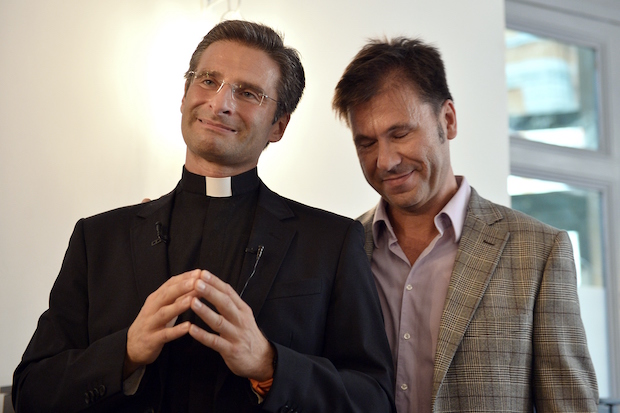Well, the Vatican isn’t the place I know a bit if the sexual orientation of the Polish priest who’s just outed himself as gay wasn’t known to everyone from the Swiss Guard to the cleaners. But still, for Mgr Krzysztof Charamsa to declare in a press conference not just that he’s homosexual but actually in a sexual relationship with his boyfriend Eduard – who looked a little less dazzlingly pleased with himself than the priest – was not just a gigantic thumbed nose to the Congregation for the Doctrine of the Faith for which he worked, but to the synod on the family which is just starting. One of the issues for the synod is the way the church engages with homosexual Catholics – though I do realise that this turn of phrase suggests that gay people aren’t actually part of the church: they are, as Mgr Charamsa has flamboyantly pointed out.
Let’s observe the obvious at the outset; had the priest declared that he was gay in the sense that other priests are heterosexual – viz, his sexual feelings are oriented to other men – then it wouldn’t have caused a stir; it wouldn’t have mattered that he was ‘happy and proud’. Catholic doctrine calls for homosexuals to be treated with ‘respect, compassion and sensitivity’ and denounces discrimination against them. The gist of the Catholic approach to homosexuality is that orientation isn’t really a problem, morally speaking.
And since all Catholic priests have to promise when they’re ordained as deacons that they won’t marry and since the only legitimate context for Christian sexual relations is heterosexual marriage, well, that rules out not just sexually active gay priests but sexually active straight ones. It’s something that Mgr Charamsa’s declaration doesn’t really deal with when he says: ‘it’s time the church opened its eyes and realized that offering gay believers total abstinence from a life of love is inhuman’.
Look, by that logic, any celibacy, straight and gay, is unacceptable – quite another debate. Respectable gay Catholics may, at this juncture, draw themselves up to their full moral height and point out to the monsignor that while their sex lives may be, for the church, ‘intrinsically disordered’, well, at least they don’t break public, explicit vows by engaging in it. Unlike him.
The whole purpose of this rather tiresome priest’s announcement – besides saving him the bother of writing a letter of resignation to the Congregation for the Doctrine of the Faith – was to put the discussion about homosexuality in the context of reality, viz, that lots of Catholics are gay and for them it’s not a problem; it’s a source of positive things, like love.
But his declaration has, rather less helpfully, pointed the difficult reality of the synod which is that while it discusses the enormous gulf between the family lives – from homosexuality to divorce – of real Christians, and the teachings of the church, it is not actually intended to bridge that gulf. It is not, for instance, going to conclude that gay sexual relations are on a par with straight ones, though I wouldn’t rule out Pope Francis taking a call from Elton John, nor is it going to compromise the church’s position that marriage is for life and therefore second marriages are tantamount to adultery.
Trouble is, the Synod has raised the expectation that its purpose is to square Church teaching and practice with contemporary moral practice. Yet it can’t, though there are all sorts of nuances that it can explore, such as the celebration of friendship between same sex couples. But I’m not sure that talking nice would cut much ice with disaffected groups, such as the interesting Global Network of Gay Catholics which Mgr Charamsa is working with, to be told that they are valued members of the church; they’re looking for something more concrete. It’s always a danger, I think, to raise unfulfillable expectations. But that’s exactly what this synod does.







Comments